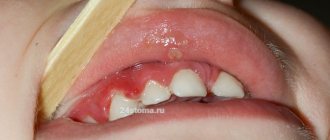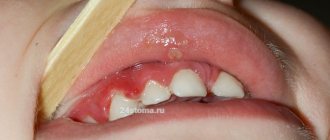Symptoms of the disease
Angina:
- pain in the throat when swallowing;
- increase in body temperature;
- the presence of purulent plugs on the tonsils;
- headaches;
- enlarged lymph nodes and their pain;
- a state of general weakness.
Chronic stage of tonsillitis:
- discomfort and pain when swallowing;
- presence of bad odor from the mouth;
- excessive fatigue;
- slight increase in body temperature;
- sleep disturbance;
- enlargement and tenderness in the cervical lymph nodes.
We care about your health
Tonsillitis is one of the most common diseases. Infections of a viral or bacterial nature enter the respiratory tract (often one of them is joined by another), causing an inflammatory process. A surge in tonsillitis is most often observed in the spring and winter, when many people have a weakened immune system. Also, this disease can develop against the background of existing foci of infections in the body, for example, with dental caries, periodontal disease, sinusitis and others.
Tonsillitis is transmitted mainly by airborne droplets, pathogens: staphylococci, streptococci, fungi, bacilli.
Tonsillitis can have both acute (called sore throat) and chronic forms. Acute tonsillitis most often occurs as a result of an exacerbation of the chronic form, when a person with reduced immunity could, for example, become hypothermic.
Symptoms of tonsillitis
Compared to chronic tonsillitis, acute tonsillitis occurs in a more severe form: the body temperature can rise to 40 degrees, the patient feels a very strong pain in the throat, and it is difficult for him to swallow. The tonsils are swollen and enlarged, with the presence of purulent plugs. Patients feel headache, weakness, and their lymph nodes are enlarged.
Depending on the type of sore throat, which can be lacunar, herpetic, catarrhal, follicular, etc., ulcers, follicles, and a film called plaque form on the palatine tonsils.
With chronic tonsillitis, the temperature can rise to 38. The patient has a light coating on the palatine tonsils, and the tonsils themselves look enlarged and reddened. A person feels weakness, muscle pain, and aching joints.
Chronic tonsillitis is characterized by stages of remission and exacerbation. During the period of remission, the focus of infection is passive, and the person is not bothered by unpleasant symptoms. But as soon as one becomes hypothermic (especially with reduced immunity), he immediately begins to feel an unpleasant sore throat, pain when swallowing, cough, fatigue, poor general health and lack of appetite. The patient's lymph nodes may become inflamed.
Chronic tonsillitis is a long-term inflammation of the pharynx and palate. Its simple form has only a local symptom: sore throat. But if the picture is complemented by persistent lymphadenitis of the neck, changes in the functioning of the heart and high temperature, then this is already a toxic-allergic form.
Chronic tonsillitis has several stages: compensated, when the source of infection is not active, and decompensated, when exacerbation occurs due to repeated sore throats, inflammation of the ear and nose.
Tonsillitis (tonsillitis) - what inflammation looks like (photo of the disease)
Photograph of the throat with purulent sore throat
Photo - throat with follicular sore throat
Catarrhal sore throat - photo
Photo - lacunar tonsillitis
Possible complications of tonsillitis
Like many other diseases, tonsillitis is dangerous due to its complications . These include, first of all, rheumatism. After suffering from a sore throat, a person may feel severe aching in the joints and an increase in temperature.
In second place, as a rule, are cardiovascular diseases. Interruptions in heart function, shortness of breath, tachycardia are sure signs that a sore throat has caused complications.
Another unpleasant symptom after tonsillitis is swelling and tenderness of the lymph nodes, which have become infected from the tonsils. This is lymphadenitis.
The infection can also spread from the tonsils to the surrounding tissues of the upper respiratory tract, leading to pain when swallowing. And this disease is a complication of tonsillitis and is called paratonsillitis.
It should be noted that more than a hundred diseases are known that arise as a result of complications after acute tonsillitis. These include a variety of kidney, eye, skin and thyroid diseases.
Diagnosis of tonsillitis
It begins, of course, with an examination by a doctor, who determines whether the tonsils and adjacent tissues are swollen and red, and whether the ear and cervical lymph nodes are inflamed. The patient is sent for a general blood test.
Before prescribing treatment to the patient, the ENT doctor determines the nature of the inflammatory process: in what form does tonsillitis occur - chronic or acute, the type of inflammation (purulent, catarrhal), is the sore throat primary or secondary, what is the causative agent (this is determined in the laboratory - a culture is done from the throat ).
Treatment of tonsillitis - specifics of therapy
In the treatment of tonsillitis, both conservative methods and surgical intervention can be used. Treatment methods depend on the specifics of the disease.
For chronic tonsillitis, if necessary, antibiotics are prescribed in tablets, and for sore throat they are often administered intramuscularly. Local treatment is also carried out: purulent plaque on the tonsils is removed, the lacunae are washed with antibacterial solutions, physiotherapy and a course of vitamins with immunomodulators are prescribed.
In case of acute tonsillitis, it is recommended to irrigate the oral cavity with antiseptic solutions, rinse, treat the tonsils with iodine-containing preparations (if there are no allergic reactions to iodine), inhalations, and resorption of antibacterial tablets are useful. You should also drink a lot (weak teas, fruit drinks, juices, rosehip decoctions, etc.), take antipyretic and painkillers.
Acute tonsillitis is not recommended to be treated with antibiotics, because they reduce local immunity. But if the form of the disease is more severe, then the patient requires mandatory bed rest and antibiotic therapy. However, the prescription of antibiotics should be preceded by an analysis of the results of culture in the pharynx area, which will identify the causative agent of the infection. It is recommended to include in the course of treatment drugs that enhance immunity, as well as general strengthening and anti-inflammatory drugs. Physiotherapy will also be useful.
If a person suffers from tonsillitis more than twice a year, has complications from this disease, and conservative treatment does not bring the expected results, then removal of the tonsils may be recommended. There are many modern methods of performing this operation (infrared laser, ultrasound, biopolar, radiofrequency ablation and others), but many consider the cold plasma coblation method to be the most effective and gentle. However, it should be remembered that the tonsils are the first protective barrier that stops and disarms pathogenic bacteria . But in many cases (especially after frequent colds), the tonsils stop performing their functions and themselves become a source of infection, causing serious complications. In this case, it is better to remove them.
Treatment of tonsillitis (tonsillitis) at the Medkvadrat ENT center in Moscow, Kurkino and Khimki.
Possible complications of tonsillitis
- Rheumatism is the most dangerous complication, which, in turn, can affect the joints and lead to heart disease.
- Pyelonephritis.
- Peritonsillitis, peritonsillar abscess.
Causes of sore throat:
- various viruses;
- bacteria;
- hypothermia of the body;
- decreased immune system functions;
- tonsil injury;
- violation of nasal breathing;
- various inflammations in the oral cavity.
Causes of chronic tonsillitis:
- frequent sore throats and ARVI;
- diseases of teeth and gums;
- nasal breathing disorder.
- weakened immune system;
- presence of allergies.
What tests need to be taken for tonsillitis?
In order to determine the pathogen and determine further treatment, the doctor may prescribe a number of laboratory tests to the patient, for example:
- a smear from the tonsils, arches and back of the throat to identify bacteria and their resistance to various groups of antibiotics, but such a study may take several days
- rapid test for the detection of group A beta-hemolytic streptococcus to determine streptococcal tonsillitis5
- a general blood test with a leukocyte formula, which pays attention to elements that reflect inflammation and the immune response to the disease. Increased band neutrophils, leukocytes, increased ESR, decreased lymphocytes
- CRP (C-reactive protein - a marker of inflammation) is the most sensitive protein responsible for inflammation in the body
Treatment of tonsillitis in the clinic
To prescribe high-quality and effective ENT treatment, the doctor must accurately determine the nature of the inflammation (acute, chronic), its type (with or without purulent content), and the type of pathogen (virus, fungus). If tonsillitis is chronic, it is important to determine whether conservative treatment will be sufficient or surgery is indicated.
Conservative treatment involves washing the tonsils, removing plugs with pus, gargling, drinking plenty of warm fluids, and taking anti-inflammatory drugs.
In no case should you self-medicate - it is better to consult a specialist who, after an examination, will prescribe you the correct treatment.
Diseases associated with chronic tonsillitis
There are quite a lot of them. Such diseases may be directly or indirectly associated with chronic inflammation of the tonsils. First of all, these are collagen diseases (rheumatism, systemic lupus erythematosus, periarteritis nodosa, scleroderma, dermatomyositis), a number of skin diseases (psoriasis, eczema, polymorphic exudative erythema), nephritis, thyrotoxicosis, peripheral nerve damage (plexitis, radiculitis). Long-term tonsillogenic intoxication can contribute to the development of thrombocytopenic purpura and hemorrhagic vasculitis.
Chronic tonsillitis often causes a prolonged increase in low temperature (low-grade fever), pathological auditory sensations (tinnitus), worsens the course of vasomotor dysfunction of the nose, vegetative-vascular dystonia, vestibular dysfunction, etc.
Chronic tonsillitis has serious complications - these include difficulty breathing due to constant swelling of the nasal cavity and its mucous membrane. It has been established that during the night, about 200 ml of pus enters the stomach, which disrupts the normal functioning of the stomach and intestines. Such patients are at risk of developing a sore throat, which often leads to a peritonsillar abscess. A peritonsillar abscess often develops into cellulitis of the neck, a disease that can be fatal. In total, up to 55 diseases can be identified that arise as a complication of chronic tonsillitis.
Tonsilloliths and what they look like
Repeated episodes of infection can cause fibrosis in the lacunae of the tonsils, leading to the accumulation of epithelial debris. These remains calcify and turn into soft or rather hard “pebbles” - tonsilloliths (from tonsillae - tonsil and litos - stone). White, grayish, yellowish, they smell unpleasant, cause a sensation of a foreign body, mild pain, and coughing. Sometimes they are released suddenly - with a sharp cough, loud scream, after a hot meal, when rinsing the mouth and throat. Treatment usually involves removal of the tonsils by an ENT doctor (curettage) [3]
A little anatomy and physiology
The palatine tonsils are located on the side walls of the pharynx and are shaped like large almond kernels. The second name - “tonsils” - tonsils received due to their resemblance to acorns, which are called “glandulae” in Latin. Since the Latin word for tonsils is “tonsilla,” their inflammation is called tonsillitis.
The palatine tonsils belong to the organs of the immune system and are small accumulations of lymphoid tissue 2. The part of the tonsils protruding into the pharynx has depressions (lacunae), in the walls of which there are numerous slit-like pockets (crypts)1. The surface of the crypts is the “working area” of the tonsils. Basic physiological processes take place here: immune cells, phagocytes, absorb microbes that have penetrated the tonsils, “study” them, send the received information to higher departments of the immune system, and then kill the infection1. If the microbes are very aggressive and there are a lot of them, and the immune system is weakened, an infectious inflammation of the tonsils develops - tonsillitis.
Up to contents











